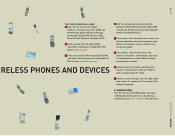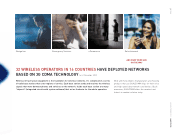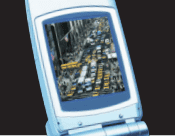Qualcomm 2002 Annual Report Download - page 16
Download and view the complete annual report
Please find page 16 of the 2002 Qualcomm annual report below. You can navigate through the pages in the report by either clicking on the pages listed below, or by using the keyword search tool below to find specific information within the annual report.
GROWING DEMAND FOR MORE MULTIMEDIA
Many subscribers to Japan’s newest 3G CDMA network have handsets with built-in cameras. The
country’s second largest operator, KDDI, is rapidly gaining market share and improving customer
loyalty thanks to a growing number of innovative devices and services.
KDDI
More than one million camera-embedded phones
were sold during the first six months of service
for KDDI’s 3G CDMA network (called “au”).
By year’s end, coverage extended to approximately
90 percent of Japan and testing was underway
for an evolution to the next-generation high-speed
data-optimized service (CDMA2000 1xEV-DO).
Over 100 applications based on QUALCOMM’s
gpsOne technology are now available in Japan.
KDDI’s “eznavigation” provides emergency
services, a child finder, detailed navigational
maps, and many other applications for con-
sumers and enterprises.
The newest handsets record and send video
“Movie Mail” in 5-, 10- and 15-second increments.
Users can input text over the images, create a
voice-over track and a GPS attachment that
provides a map detailing the precise location of
the sender.
NTT DoCoMo
“Photo Mail” users can send images to PCs
and Internet-enabled phones such as the
FOMA handsets used by Japan’s NTT DoCoMo,
the first commercial network based on WCDMA
(Wideband CDMA) technology.
IT’S HAPPENING IN JAPAN
Notes: The 2002 figure includes 136,000 FOMA
subscribers as reported on the NTT DoCoMo web site.
The 1999-2001 data as of 12/99, 12/00, 12/01.
The 2002 data as of 11/02.
Sources: KDDI web site, NTT DoCoMo web site, 11/02.
C D M A S U B S C R I B E R G R O W T H
JAPAN
3M
7M
10M
13M
1999 2000 2001 2002
























